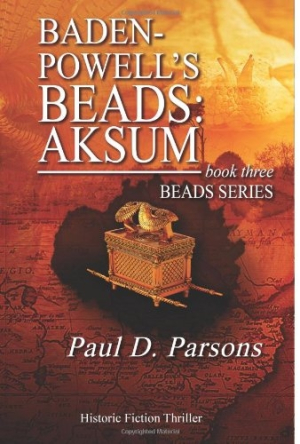Baden-Powell's Beads: Aksum
book three: Beads Series
Parsons’s narrative ability enlivens the intense action scenes in this historically influenced espionage tale.
Baden-Powell’s Beads: Aksum combines historical fact with a fictional quest to prevent an Ethiopian megalomaniac from acquiring twenty-four beads made of the same wood as the Ark of the Covenant and imbued with supernatural power. This third book in the series is an enlivening tale of espionage, action, and adventure.
Paul D. Parsons continues his story of Homeland Security Agent Patrick Dartson’s search for the beads, allegedly given to Robert Baden-Powell, founder of the Boy Scouts movement in Britain, by Zulu warriors. After the confrontation that caused his best friend’s death in London, as the second book in the series ended, Patrick comforts Pam Blanchard, fiancée of the deceased man. Their shared sorrow grows into a deeper bond, and Pam, a nurse, decides to join Patrick and his assistant, Adnan Fazeph, despite her lack of training in intelligence work.
The three protagonists each wear a bead, acquired from their vanquished comrades, that warns them of impending danger. Pursuit of the other beads takes them from the United States to Great Britain and finally to Ethiopia, where they face daunting challenges.
Historical and fictional backstory unfolds in tandem with plot progression. A chapter set in Egypt in 1440 BC focuses on Bezaleel, a carpenter who has been told by Moses to build the Ark of the Covenant. With the remaining acacia wood, he carves the magical beads for a necklace. The story then returns to the present, and Ras Marcus, a Jamaican Muslim, and Lij Mered, the self-proclaimed Emperor of Ethiopia, along with other characters, convey more information. While interesting and pertinent to the plot, this abundant detail occasionally devolves into exposition.
Characters Patrick and Adnan are clearly portrayed, as evidenced by their clever repartee. When Adnan questions Pam’s inexperience as an undercover agent, Patrick replies, “Let me worry about that. My gut tells me she’s important in this somehow.” Adnan, who affects a Middle Eastern speech pattern, responds, “I think maybe you confuse gut with other parts.”
Parsons’s narrative ability enlivens the intense action scenes. For example, when the story moves to Lij Mered’s army recruitment camp in the hills near Aksum, Adnan poses as a potential warrior to infiltrate Mered’s inner circle. As groups of three aspirants compete in foot races across the vast plateau, he learns that those who place last will be shot as losers. “Lij Mered also wants no one in his army who has no stomach for killing,” Adnan’s companion explains. “The two winners of each race have the honor of killing the loser.”
The Aksum episode of the Baden-Powell’s Beads series features the kind of bloody events and crafty characters typical of espionage thrillers. Protagonists make use of advanced technology to save people in distress while their antagonists compensate for less advanced weaponry with unremittingly cruel intent. The major male characters are quite fully realized; however, female participants in the drama, such as Pam and Cheri Hassan, Mered’s cohort, play simpler roles as sexy accomplices.
Readers who like tales of mystery and adventure will enjoy this book. The surviving characters promise renewed confrontations in the projected continuation of this series.
Reviewed by
Margaret Cullison
Disclosure: This article is not an endorsement, but a review. The publisher of this book provided free copies of the book and paid a small fee to have their book reviewed by a professional reviewer. Foreword Reviews and Clarion Reviews make no guarantee that the publisher will receive a positive review. Foreword Magazine, Inc. is disclosing this in accordance with the Federal Trade Commission’s 16 CFR, Part 255.

